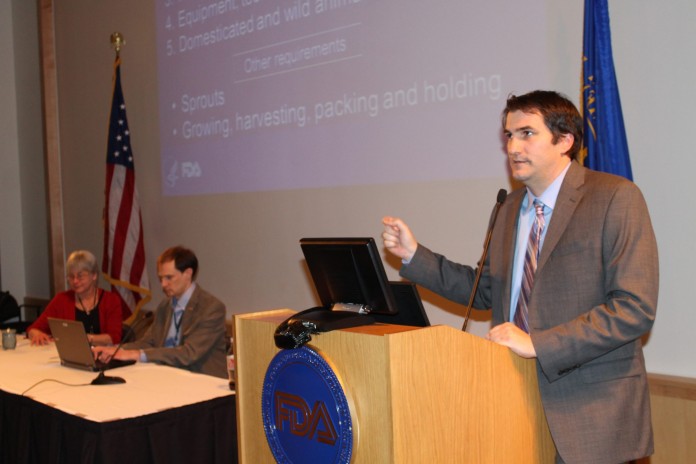(Event to be held April 30, 1 to 4 p.m. in the Shisler Conference Center on the Wooster campus of OARDC)
WOOSTER, Ohio — If you’ve been following the produce industry over the past half-dozen years, chances are good you’ve heard the words “food safety.”
It’s been a hot topic in the industry, amid costly foodborne illnesses and concern over the general safety of raw produce.
A proposed set of new food safety rules was introduced in the Federal Register Jan. 4, which meets the requirement of the federal Food Safety Modernization Act. The proposals to date are based on research and producer input, but they’re not final.
Listening session
The Food and Drug Administration is seeking public input on the new rules and will hold a listening session April 30 at the Ohio Agricultural Research and Development Center in Wooster.
Samir Assar, director of FDA’s produce safety staff, will be at the meeting, along with two other FDA officials: Michael Taylor, deputy commissioner for foods and veterinary medicine, and produce safety expert Joy Johanson.
Assar said the FDA’s goal with the session is to explain where the food safety rules stand today and how they will affect the industry — and to listen to any comments and concerns. The day will include a question and answer session.He called it an “opportunity (for FDA) to engage with the produce community.”
The public comment period is scheduled to end May 16, with the new rules to become effective a year later. But those dates could change if the staff feels a need to extend the comment period, Assar said.
Return visit
It won’t be the first time he has visited Ohio to discuss produce regulations.
Assar spoke to Ohio growers at the annual Ohio Produce Growers and Marketers Association summit in Sandusky, and most recently on the Ohio Farm Bureau Federation’s annual county presidents’ trip to Washington in early March.
Assar said about 150 comments have been added to the rule’s official register, based on all questions and comments so far.Mandatory listening sessions were held in Washington, Chicago and Portland, Ore., and FDA is now holding sessions in cities where local sponsors have arranged for a meeting.
The April 30 meeting is sponsored by the Ohio Department of Agriculture and Ohio State University.
What’s included. As it stands, the rule sets standards for all aspects of unprocessed fruits and vegetables sold off a farm. It covers such specifics as agricultural water, biological soil amendments of animal origin, health and hygiene, animals in the growing area and equipment, tools and buildings. The proposed rule includes additional provisions related to sprouts.
It would not apply to raw agricultural commodities that are rarely consumed raw, those produced for personal or on-farm consumption, and (with certain documentation) those destined for commercial processing, such as canning.
Some farms would not be covered by the rule, or would be eligible for a partial exemption based on the monetary value of their food sales and to whom they sell. The partial exemption would still subject eligible farms to certain requirements, and could be withdrawn in certain circumstances.
Good practices
Many of the new rules are already followed by produce farmers on a voluntary basis, known as Good Agricultural Practices or GAPS.
“A big difference is that the rule will provide enforceable standards,” Assar said. “We think setting forth enforceable standards is the appropriate approach for ensuring produce safety.”
The FDA will have enforcement and inspection powers over farms that do not comply.
But Assar said the goal is “doing what we can to bring those firms into compliance,” which is part of the reason the FDA is traveling the country — to tell producers what the rules will be.
Improving safety
The goal of the new rule is safer food and reducing the public health burden of foodborne illness. The FDA estimates the new rule will prevent 1.75 million foodborne illnesses, with an associated benefit of $1.04 billion annually.
It estimates the annualized costs of the proposed rule to be $459.56 million annually for domestic farms, and $170.62 million annually for foreign farms covered by the rule, for a total of $630.18 million annually.
The proposed rule would cover an estimated 40,496 domestic farms and 14,927 foreign farms.
How the regulations would affect you:
The proposed produce safety rules affect producers differently based on the size of their operation and how much they sell. Here is the breakdown:
Very Small Business. A very small business is defined as having, on a rolling basis, an average annual monetary value of food sold during the previous three years of no more than $250,000. These farms would have four years after the effective date to comply; for some of the water requirements, they would have six years.
Small Business. A small business is defined as having, on a rolling basis, an average annual monetary value of food sold during the previous three years of no more than $500,000. These farms would have three years after the effective date to comply; for some of the water requirements, they would have five years.
Other Business. Other businesses would have to comply two years after the effective date. For some of the water requirements, they would have four years to comply.











